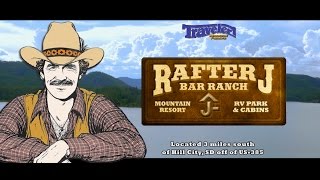Monday, 12 January, 2026г.
















Где искать: по сайтам Запорожской области, статьи, видео ролики
пример: покупка автомобиля в Запорожье
20121007; Hill City SD's 1880's Train Ride
7 Oct 2012: During our visit to the Black Hills we discovered the 1880's Train Ride attraction. This ride originates at Hill City, SD and terminates at Keystone, SD where the train's engine decouples, takes on fresh water, then backs up to re-attach itself to what had been the rear of the train for the return trip to Hill City.
If you're not a "train" enthusiast, you may not enjoy this video. We have reduced the 2 hour and 15 minute round trip into a 48-minute documentary as experienced one way. It captures the view as seen by a passenger aboard one of the cars located near the front closest to the locomotive, sitting on the left side of the train. By comparison with more modern passenger cars, the view is somewhat limited. There are a total of 20 road crossings encountered, with each crossing having the locomotive whistle the requisite preamble Morse code letter "Q" as it approaches...two long, a short, and a long whistle...having its origins back in the day when the Queen of England would be aboard a ship, with the ship's captain announcing her presence by blasting the letter "Q" using the ship's whistle.
Along the way you will witness close-up trees of the Black Hills, Harney Granite outcroppings, rocks sparkling with mica, private homes (one built on a pile of rocks), a chance to waive at Tom, a church camp, a glimpse every now and then of the Old Hill City Road...in itself a scenic drive from Hill City to Keystone, SD. And of course, in the background you will hear the nervous chatter of small children...an undocumented feature of the trip! As you arrive at Keystone, you can witness the operation of a modified railroad "Wye," the method used to turn a train around.
As you travel along the route, you are provided with an ample amount of narrative describing the history of SD, the train, and aspects of living in the Black Hills. There is both recorded and live narration...all of it interesting and pertinent to the trip. Included is a small list of movies in which the train was featured as part of the script. And...you can get your picture taken while you sit in your seat, and have it prepared for you while you travel! And...they do provide for sale a small booklet pertaining to their operations.
The end of this video features several still photos taken along the way.
Engine #110, a 2-6-6-2 compound articulated standard gauge Mallet locomotive named after its developer, Swiss engineer Anatole Mallet, was employed for our trip. The Mallet has two engines independently mounted on an articulated frame. A high pressure engine located at the rear exhausts steam which is carried forward to a low pressure engine mounted on the articulating part of the frame located at the front of the locomotive. These locomotives work well along the narrow, winding track often associated with mountain rail lines.
Теги:
1880 Train South Dakota Hill City Keystone Train Ride Old Hill City Road Mallet ColoradoGeorge #110
Похожие видео
Мой аккаунт


 У вашего броузера проблема в совместимости с HTML5
У вашего броузера проблема в совместимости с HTML5


